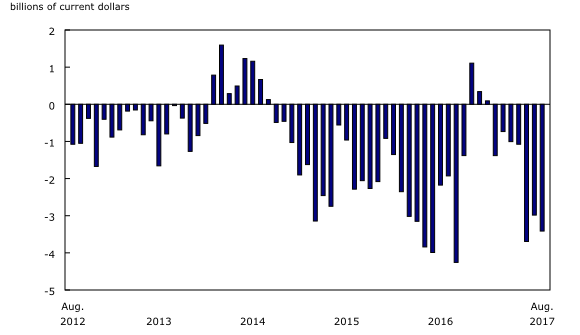
Canada’s merchandise trade deficit totalled $3.4 billion in August, widening from a $3.0 billion deficit in July.
Exports down for a third consecutive month
Following two months of large decreases, exports were down a further 1.0% to $43.6 billion in August—despite increases in 6 of 11 sections. Exports have fallen 10.6% since the record high posted in May. Volumes decreased 1.9% in August, while prices were up 1.0%. Consumer goods, basic and industrial chemical, plastic and rubber products, as well as metal ores and non-metallic minerals were responsible for the decline in export values. Exports excluding energy products were down 1.4%. Year over year, total exports edged down 0.2%.
Exports of consumer goods were down 3.8% to $5.7 billion in August, the third consecutive monthly decline. Pharmaceutical and medicinal products (-8.6%) led the decrease, mainly on lower exports to Italy. Prepared and packaged seafood products also contributed to the decline, down 10.5%, following the close of the snow crab fishing season at the end of July. Overall, volumes fell 2.4% and prices were down 1.4%.
Exports of basic and industrial chemical, plastic and rubber products declined 5.9% to $2.7 billion. Basic chemicals decreased 8.3% to $562 million in August, returning to June levels following increased exports of ethylene glycol to China in July.
Exports of metal ores and non-metallic minerals, down 9.7% to $1.5 billion, also contributed to the decrease. Lower exports of radioactive ores and concentrates (-75.3%) were attributable to shutdowns at uranium refining facilities in August. Overall, prices were up 14.7% while volumes were down 21.2%.
Offsetting movements in imports
Following the largest decline since January 2009 in July, total imports were virtually unchanged in August. Notable offsetting movements were observed in motor vehicles and parts (+2.5%), metal ores and non-metallic minerals (+9.9%), consumer goods (-1.8%) and aircraft and other transportation equipment and parts (-10.2%). Year over year, total imports were up 3.0%.
Imports of motor vehicles and parts rose 2.5% in August to $9.3 billion. Following a 17.9% decrease over June and July, imports of motor vehicle engines and motor vehicle parts were up 5.3% in August. This year, planned summer closures in the automotive manufacturing industry were more concentrated in the month of July compared with previous years. Overall, volumes increased 2.1% and prices were up 0.4%.
Imports of metal ores and non-metallic minerals rose 9.9% to $1.2 billion in August on higher volumes. Other metal ores and concentrates (+15.0%) were responsible for the increase, mostly on higher imports of lead. There were no imports of lead from Peru in July due to a national strike in the mining industry in that country.
Imports of consumer goods fell 1.8% to $10.1 billion in August, the fourth consecutive monthly decrease. Clothing, footwear and accessories (-5.9%) led the decline, mostly on lower clothing imports from Bangladesh. In the section as a whole, volumes were down 1.3% and prices decreased 0.4%.
Lower exports to the United States
Exports to the United States were down 1.8% to $32.6 billion in August, notably on lower exports of unwrought gold. Imports from the United States rose 0.9% to $30.3 billion. As a result, Canada’s trade surplus with the United States narrowed from $3.2 billion in July to $2.3 billion in August. The Canadian dollar gained 0.5 US cents relative to the American dollar from July to August.
Imports from countries other than the United States decreased 1.6% to $16.7 billion in August. Lower imports from China (cellphones), Saudi Arabia (crude oil) and Norway (ships) were partially offset by higher imports from Mexico (motor vehicles and parts).
Exports to countries other than the United States rose 1.5% to $11.0 billion, as increased exports to the United Kingdom (unwrought gold) and Japan (coal and canola) were partially offset by lower exports to China (canola) and India (uranium). Consequently, Canada’s trade deficit with countries other than the United States narrowed from $6.2 billion in July to $5.7 billion in August.
Real exports decrease in August
In real (or volume) terms, exports decreased 1.9% in August. For the first time since 2011, real exports declined for three consecutive months. Real imports edged up 0.2%. Consequently, Canada’s trade deficit in real terms widened from $378 million in July to $1.3 billion in August.
Revisions to exports and imports in July
Revisions reflected initial estimates being updated with or replaced by administrative and survey data as they became available, as well as amendments made for late documentation of high-value transactions. Exports in July, originally reported as $44.1 billion in last month’s release, were virtually unchanged in the current month’s release. July imports, originally reported as $47.2 billion in last month’s release, were revised to $47.0 billion.









